Color temperature is generally understood to be the color of light. Technically speaking, it is the scientific measurement of the temperature at which a black body would emit radiation of the same color as a given object. How does a temperature scale become a measurement of color?
Table of Contents
What is Color Temperature?
Before moving forward, it is important to note that the terms cool and warm do not relate to the temperature on the Kelvin numbering scale. Instead, the color shift is a correlation observed when reading temperature. Color doesn’t have a temperature, but temperature has a color.
To understand this, it helps to look into where the measurement comes from. Before the creation of thermometers, smiths, potters, and glassblowers depended on the color of the glowing material to track progress. Consider what happens when an iron bar is heated to a soaring temperature. First, it glows red, then as the temperature rises, it becomes blue-white. These craftspeople worked with the understanding that most minerals had a unique color at different levels as the minerals heated.
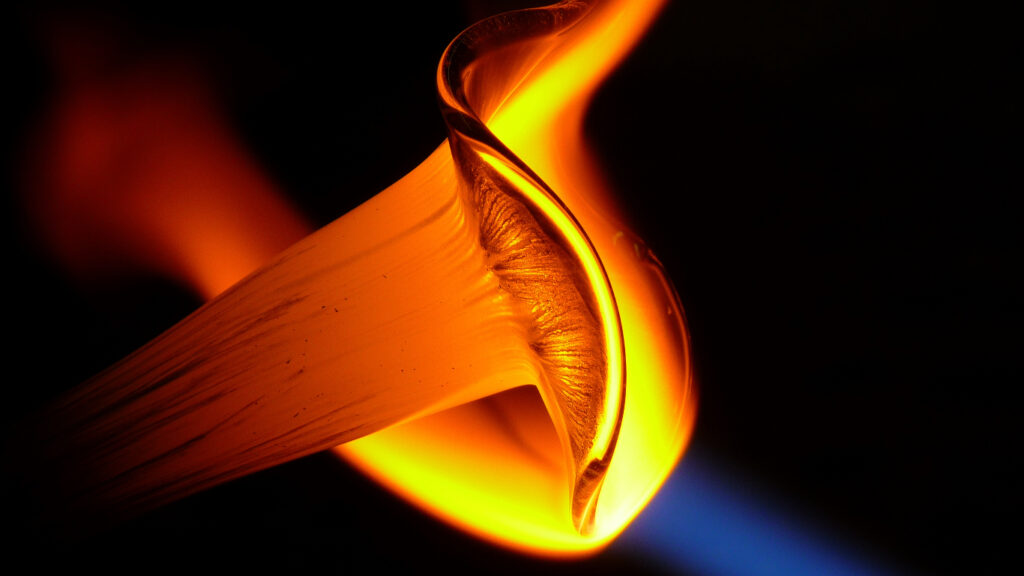
The History and Science of Color Temperature
In 1665, Issac Newton darkened his Cambridge University room and made a hole in his window shutter to allow a single beam of sunlight to enter. He took a glass prism and placed it in the sunbeam. The result was a multicolored band of light known as a color spectrum. Newton then placed a second prism, and the rainbow was restored to white light. Newton was the first scientist to prove that white light is comprised of all visible colors.
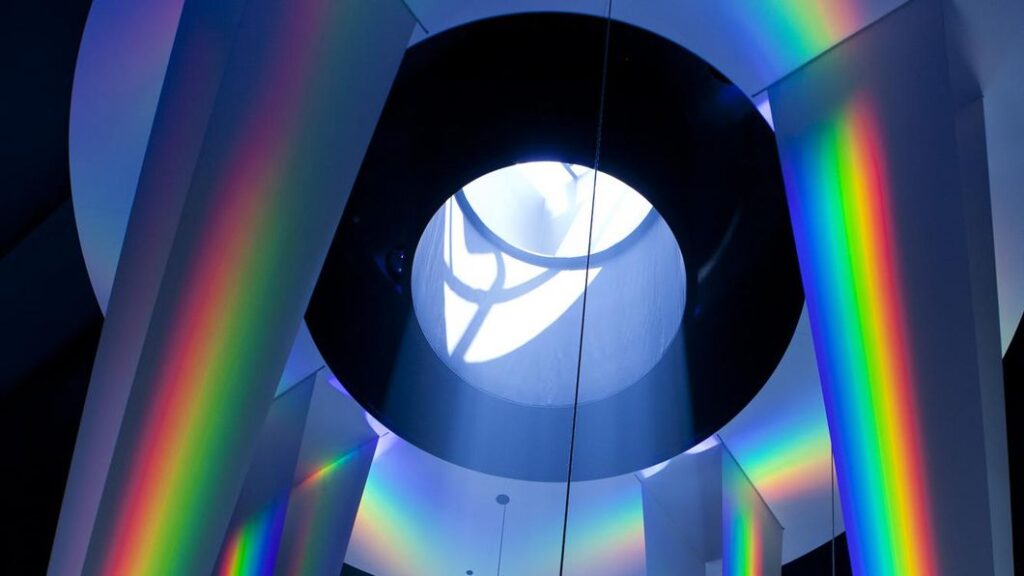
In 1724, Daniel Fahrenheit devised a mercury thermometer using the number 180 as the number of steps (degrees) between freezing and boiling water. In 1742, almost two decades later, Anders Celsius created a measurement that put 100 steps between those same two points.
The prism’s role in separating the different colors of visible light was combined with the use of specialized thermometers in 1800 when William Herschel discovered infrared while studying the heating effects of different colors of light.
In 1802, Joseph Louis Gay-Lussac proved that a tube floating atop a column of hydrogen would rise and fall uniformly with temperature. With this knowledge, he also noted that if cooling continued, the tube would hit bottom at -273℃. Scientists refer to this bottoming out as absolute zero. At this point, particles will have minimal motion and disorder disappears. Because there is minimal movement, there is nothing to create heat, meaning that nothing can be colder than absolute zero.
The Kelvin Scale and Electromagnetic Radiation
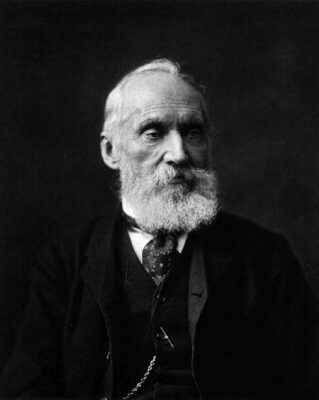
William Thomson, better known as Lord Kelvin, is best known for his work on Black Body Radiation. He used a temperature scale in his work, which now bears his name, Kelvin (K). The International System of Units (SI) for thermodynamic temperature begins at absolute zero. It uses the same magnitude as Celsius degree, meaning that the difference between water freezing and boiling is 100 degrees in both scales.
Lord Kelvin’s work focused on the dynamical theory of heat, which states that heat is different from other forms of energy in that it does not get stored within a system. Instead, it is always energy in motion. This motion is called an electromagnetic wave.
Electromagnetic radiation is radiation that has both electric and magnetic fields, and travels in wavelengths. These wavelengths, or frequencies, come in seven types. The seven wavelengths are:
- Radio waves
- Microwaves
- Infrared waves
- Visible light waves
- Ultraviolet waves
- X-rays
- Gamma rays
According to Kelvin’s findings, an idealized opaque, non-reflective body (also known as a black body radiator) at absolute zero emits no detectable energy. When heated, the atoms and molecules release part of their energy in the form of electromagnetic radiation light. Electromagnetic light waves, represented in increasing energy, go from infrared to visible light (red to orange to yellow to green to blue) to ultraviolet. Visible light is the section of the electromagnetic spectrum that is discernible by the human eye.
To put this into perspective, in the dark, the human eye begins to pick up the emissions of energy somewhere around the 773K range in the form of gray. This is because the intensity is so low that it only activates the eye’s grey-level sensors. With the rising temperatures, this glow becomes visible even with background light.
This can be easily seen when heating iron. As the temperature of the object rises a color shift is noticed, first as a dull red, then yellow, and into a blueish-white. With the documentation of this visible spectrum shift, the temperature became known by its color. Today this visible spectrum shift is represented by Correlated Color Temperature.
The Origin of Correlated Color Temperature (CCT)
The year 1931 was big for the science behind determining temperature using color. The International Commission of Illumination announced the XYZ color space providing a way to visually represent light and color in the form of graph coordinates. Y represents luminance, while X and Z contain all possible chromaticities of that luminance, or the objective specification of the quality of color regardless of its luminance. American physicist Deane B. Judd published a paper on the nature of chromatic stimuli, or the difference between the sensation of chromaticity. American chemist and physicist Raymon Davis coined the term Correlated Color Temperature (CCT), which he defined as the primary component temperatures using trilinear components (or XYZ).
Correlated color temperature is the temperature of a black body radiator whose perceived color most closely resembles that of a given stimulus at the same brightness and under specified viewing conditions. CCT uses XYZ color space and the sensation of chromaticity to measure how the visible spectrum of white light appears on the warm to cool scale relative to degree Kelvin. This math allows for an approximation of the color temperatures of various light sources.
Using CCT, it was determined that the visible light spectrum hosts temperatures between 1,000K to 10,000K. The color of natural sources had an approximate Kelvin temperature. Daylight is generally very cool, with color temperatures of 5300K to 5500K. Sunset and sunrise, in contrast, are warmer with a Kelvin measurement of 2000K to 3000K.
Artificial light has as much variation in CCT as natural sources. Candlelight is somewhere in the 1,850K to 1930K range. Typical household tungsten and standard incandescent lights exist in the 2500K to 2900K range. Theatrical applications use Halogen light sources that are in the 3000K range. A Compact Fluorescent Lamp (CFL) falls into the 4200K range, making it close to the same color temperature as found in the mid-morning and mid-afternoon sun.
Correlated Color Temperature versus Color Rendering Index
CCT is used to determine the temperature of a light at the source, but in the mid-20th century, color scientists took an interest in assessing how artificial lights could accurately reproduce colors. The Color Rendering Index (CRI) was created for this purpose.
CCT and CRI measure different aspects of color. CCT is the color of the light emitted by the source by looking at the source. CRI measures the reflected color value of an object under the light source or how the light source “renders” the colors of an object. This is measured on a scale of 0 to 100, with 100 being the full spectrum of visible light and the most accurate color representation.
An object’s color of an object is determined by its reflected color wavelength. For example, a candy apple appears red because it reflects the red wavelengths and absorbs all other colors in the visible spectrum. If an artificial light bulb appears to have a CCT equal to natural daylight, one can use CRI to determine if it accurately represents the same spectrum. If it does have the same spectrum, then the reproduction (R) will be identical and portray the same color range as the original source. If it is missing part of the visible light spectrum, the reflected color will appear distorted or less vibrant.
The method for measuring CRI is similar to the visual assessment made with the candy apple but is done using algorithmic calculations once the spectrum of the light source is measured. First, the CCT for the light source must be calculated to select the appropriate spectrum to use for comparison. This source will be shined upon a series of color swatches with the reflected color measured. The two color samples are compared and formulaically determine the R score for each color swatch. The R-value for a particular color indicates the ability of a light source to accurately render that particular color. The only way to accurately measure a light source’s CRI value is to use a specialized spectral measurement device. The data accumulated by these devices are what lighting manufacturers rely on to guarantee color rendering realistic metrics.
When referring to light accuracy, each color temperature has a “reference standard,” which is the light source that provides the most natural lighting for comparison. For instance, 6500K has a reference standard that is about equal to the light at noon on a bright summer day. To make this comparison, the light bulb would be compared to the light from its reference standard. This requirement to have a color temperature value to determine the comparison color means that CRI is almost meaningless on its own. A light bulb with a 95 CRI seems impressive until it is revealed that it is compared to the wavelength of a 2700K incandescent light bulb.
Because of this, it is important to consider color temperature for the application first and then consider CRI afterward. Want a room to replicate the light of natural daylight? Pick a high color temperature value (5000K or higher) and then find a light bulb in that range with a high CRI value after.
Color Temperature in LEDs
The traditional lightbulb emits light by heating a wire filament with an electric current to emit energy packets of light called photons. LEDs use a phenomenon where photon emission is created by the electronic excitation of a material to create light. The most frequently used material is gallium arsenide, but there are many variations of this compound used. All of these compounds are found on the III to V group of semiconductors, or compounds found in columns III and V of the periodic table. This is important to remember because depending on the combination of semiconductors, the wavelength (and color, in turn) can be changed. Each combination is matched to a Kelvin and its corresponding CCT.
LED lightbulbs will also include a CRI number to provide the accuracy of color rendering, which averages between 80 to 90 on the CRI scale. This accuracy makes them better suited to an indoor environment than alternative lighting options (such as the average fluorescent tube that averages a CRI of around 50).
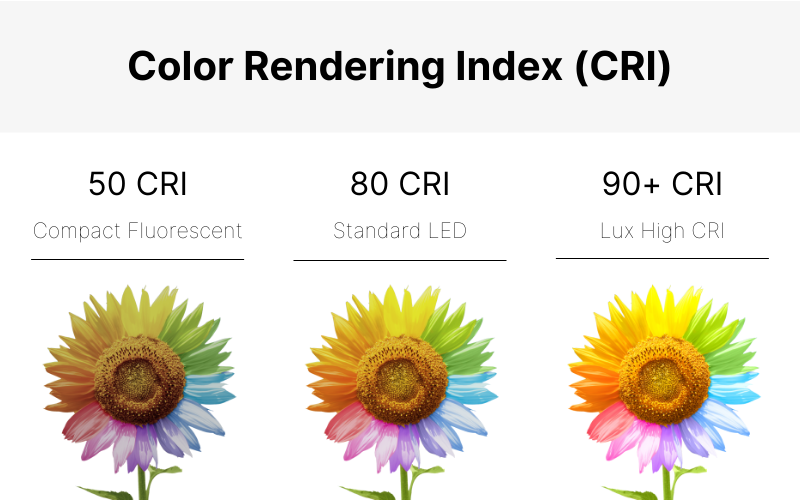
The Role of Color Temperature in Lighting Design
Think of a time an office meeting room felt overwhelming. Now consider the relaxing sensation of a campfire. These examples are on opposite ends of an emotional sensation: one oppressive and the other alleviating. Now think of the color temperature of those situations. The campfire was warm in color, while the office was cold. In both situations, the color of the light plays a role in the brain’s reaction to the environment. For this reason, choosing the correct color temperature could be one of the most important factors in lighting a space.
The natural color temperatures seen throughout the day vary from warm to cool to warm. This is a pattern that helps influence the internal clock called the circadian rhythm. In the natural world, there are three sources of light: the sun, the night sky, and fire. Artificial light impacts our cognitive processes. Our bodies are wired to release hormones at different times of the day, affecting mood and alertness. Our minds are most active when the sun is at its brightest, but as the sun reaches the horizon, the body starts to quiet down and relax. Light signals our brains to control our hunger response, body temperature, and hormonal secretion. Recent studies show positive health shifts in environments where artificial lighting mimics the temperatures of the sun throughout the day.
Studies show that the minds can be tricked into behaving in specific ways based on the color temperature. Warmer light tends to be more relaxing because our internal clocks associate it with the ending of the day and preparing to sleep. Cooler colors have the opposite effect because that clock tells the brain it is the middle of the day and should be active. With that knowledge, color temperature is best selected by considering the use of the space.
- When sharp focus is needed, select a color temperature that is closer to daylight in the 3500K to 4100K spectrum.
- For relaxation, place lamps that are closer to golden hour sunlight or candlelight (2000k- 3000k).
- In areas that fluctuate purposes, mimic the angle of the sun when selecting a color temperature.
- Place a “neutral” color temperature in overhead fixtures in the 3500K to 5000 range for tasks that need more attention.
Daylight at the beginning and end of the day is somewhat warm, and many believe that the interior should respond in a similar manner. As the height of the fixture approaches the floor, the color temperature warms up, mimicking the natural cycle of the sun.
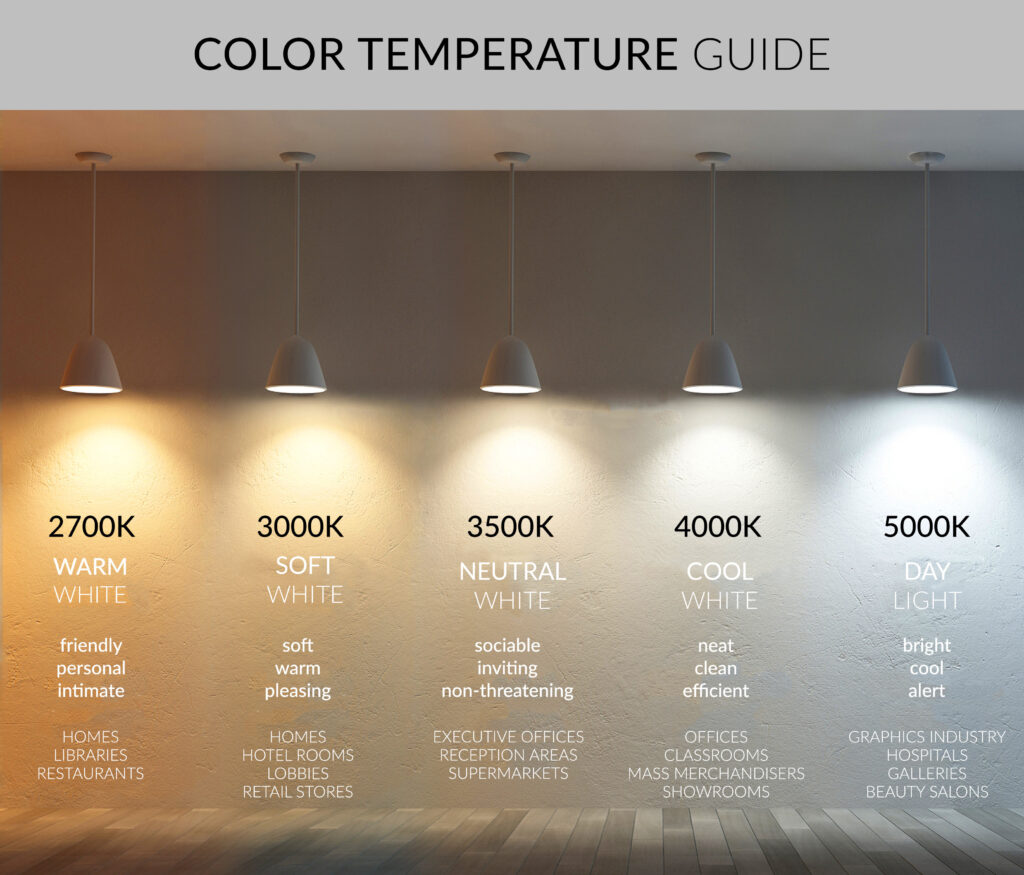
Cool White light, color temperatures 5000K and over, add a bluish tint to existing colors. This color range flattens reds and enhances existing blues. Cool whites create a crisp, invigorating, and attentive mood due to the similarity to the intensity and clarity of sunlight. Lamps in this range are often used in warehouses and industrial facilities. The most accessible temperatures in the cool spectrum are Bright White and Daylight White.
Bright White, 5000K on the color scale, is vibrant and crisp without distorting color. This is the range that best fits OSHA regulations. Because of this, this color range is often used in warehouses, stadiums, and healthcare environments. Daylight White light, at 6500K, is a favorite of designers for things such as interior agriculture, art studios, security lighting, auto body shops, street lamps, and large industrial spaces. This spectrum is great for these applications because it resembles daylight. This similarity ensures consistency of color throughout the day.
Neutral White light, with color temperatures between 3500K to 5000K, enhance all existing colors. This color accuracy makes this range widely used in retail, offices, and showrooms. This color range enhances efficiency and vibrancy while still giving the feeling of balance to a space. The two color names in this temperature range are Neutral White and Cool White. Often represented in this range is the “Neutral White, or 3500K color temperature. Considered the closest to true white, this color temperature is used in office spaces and retail stores. The name Cool White is a bit misleading. This color has a temperature of 4100K, well within the neutral color range. On the cooler end, this color is great for areas where precision, cleanliness, and focus are important, such as garages, art studios and grocery stores.
Warm White light, color temperatures 3500K and below, add an amber tint to existing colors. This causes the reds to appear more vibrant and the blues to appear duller. This color range feels welcoming, cozy, calm, inviting and intimate, which is why it is used in homes, restaurants, spas, and hospitality projects. Warm White is considered to be the color temperature most frequently bought for the home and has a temperature reading of 2700K. This specific temperature is used in living rooms, restaurants, and hotels. On the cooler end of this range is the color known as Soft White, which has a measurement equal to 3000K. This provides a relaxing ambiance with more clarity, so it is often placed in bathrooms and home kitchens.
In rooms where daylight provides ambient lighting, designers should select a commensurate color temperature. As established, daylight is on the cooler end of the spectrum. Lamps in the 5500k and over range appear to be too cold after the sun has set. For this reason, some designers choose to place lamps in the 3500K and 4100K range. This neutral range isn’t too warm when combined with daylight and doesn’t appear blue in the evening. 3000K will be noticeably warmer and may suit when a warm color temperature is desired at night.

Citations:
Augustyn, A. (2019, April 4). Celsius. Encyclopædia Britannica. Retrieved April 13, 2023.
Augustyn, A. (Ed.). (2023, February 5). Fahrenheit Temperature Scale. Encyclopædia Britannica. Retrieved April 13, 2023.
Davidson, M. W. (2015, November 13). Color Temperature. Molecular expressions: Science, Optics, and you: Light and color – color temperature. Retrieved April 13, 2023.
Davis, R. (1931). A Correlated Color Temperature for Illuminants. Bureau of Standards Journal of Research, 7(4), 659.
Durmus, D. (2021, July 25). Correlated Color Temperature: Use and Limitations. Sage Journals. Retrieved April 18, 2023.
Fu, X., Feng, D., Jiang, X., & Wu, T. (2023, February 20). The Effect of Correlated Color Temperature and Illumination Level of LED Lighting on Visual Comfort during Sustained Attention Activities. MDPI. Retrieved April 17, 2023.
Gaur, A. (2023, January 13). Conservation of Energy. Encyclopædia Britannica. Retrieved April 14, 2023.
Gregersen, E. (2021, February 10). Absolute temperature scale. Encyclopædia Britannica. Retrieved April 14, 2023, from
Helmenstine, A. (2023, January 18). What is Absolute Zero? Temperature in Kelvin, Celsius, and Fahrenheit. Science Notes and Projects. Retrieved April 13, 2023.
Lin, J., Ding, X., Hong, C., Pang, Y., Chen, L., Liu, Q., Zhang, X., Xin, H., & Wang, X. (2019, May 17). Several Biological Benefits of the Low Color Temperature Light-Emitting Diodes Based Normal Indoor Lighting Source. Nature News. Retrieved April 17, 2023.
Lotha, G. (2023, March 16). LED. Encyclopædia Britannica. Retrieved April 17, 2023.
Lotha, G. (2023, March 21). Absolute Zero. Encyclopædia Britannica. Retrieved April 14, 2023.
Merriam-Webster. (2023). Color Temperature Definition & Meaning. Merriam-Webster. Retrieved April 13, 2023.
Regents of the University of California. (2023). Forum Question: How Much Heat Does a Red, Orange, Yellow, Green, Blue, Purple, Black, and Pink Light Give Off? UCSB Science Line. Retrieved April 13, 2023.
Sanker, E. A. (2023, March 11). What Is the Color Rendering Index? All the Science. Retrieved April 17, 2023.
Sarola, J. (2020, April 7). Sir Frederick William Herschel, Infrared Light (IR) Discoverer. Sir Frederick William Herschel, infrared light (IR) discoverer | NIRS Research. Retrieved April 14, 2023.
Scientific American. (1998, November 16). Ask the Experts: What is Charles’ Law? Scientific American. Retrieved April 13, 2023.
Sharlin, H. I. (2022, December 13). William Thomson, Baron Kelvin. Encyclopædia Britannica. Retrieved April 13, 2023.
Yaguchi, H., David, A., Fuchida, T., Hashimoto, K., Heidel, G., Jordan, W., Jost-Boissard, S., Kobayashi, S., Kotani, T., Luo, R., Mizokami, Y., Ohno, Y., Pardo, P., Richter, K., Smet, K., Teunissen, K., Tsukitani, A., Wei, M., Whitehead, L., & Yano, T. (2023). Colour Fidelity Index for Accurate Scientific Use. CIE. Retrieved April 17, 2023.
Lindsay Alayne Stevens is a multidisciplinary designer, artist and writer. She holds an MFA in Theater Design (Lighting) from UCSD ('21) and BFAs with High Honors from Marlboro College in Theater, Photography, and Writing ('17). She works as a freelance lighting designer and teaches lighting at the university level.





